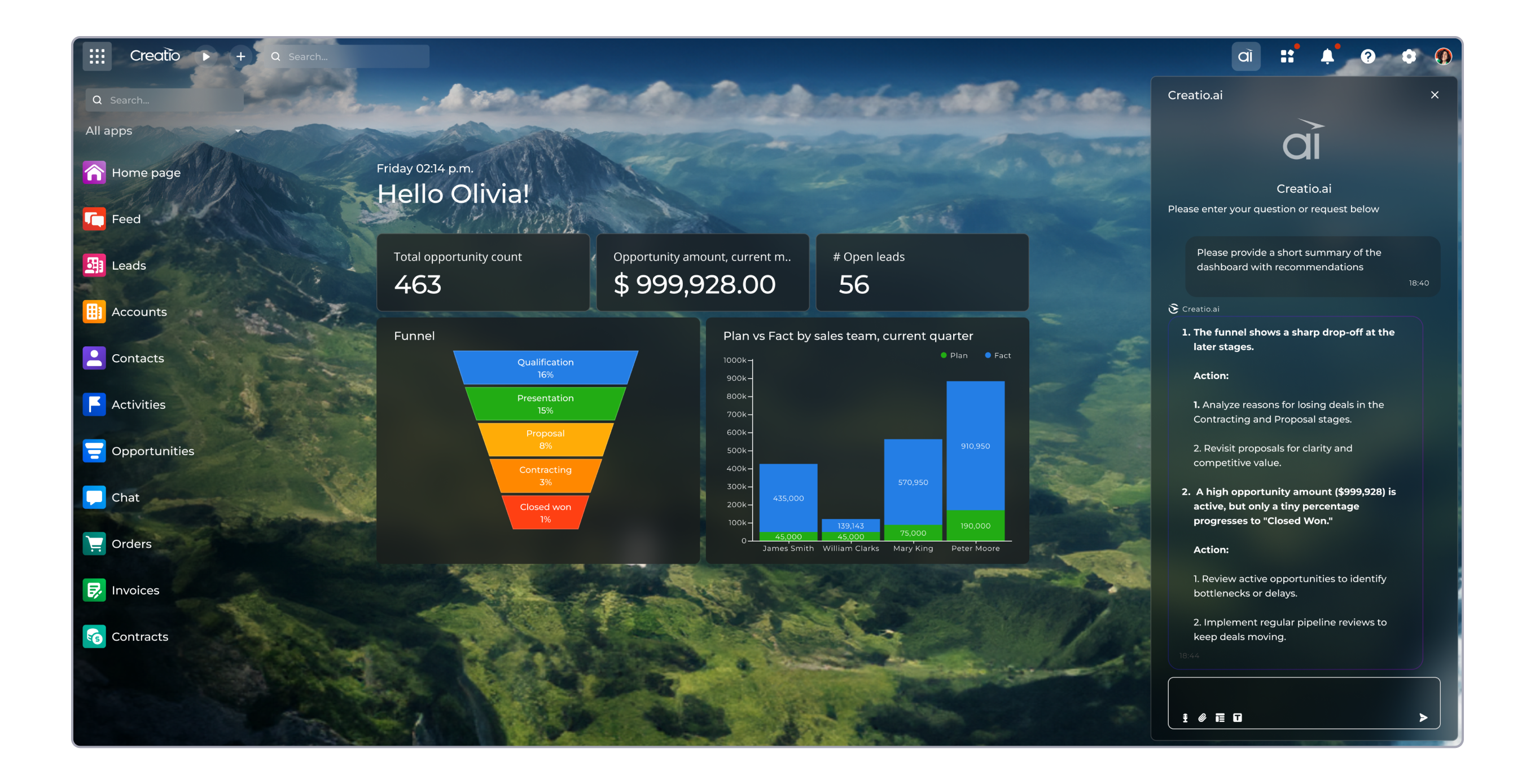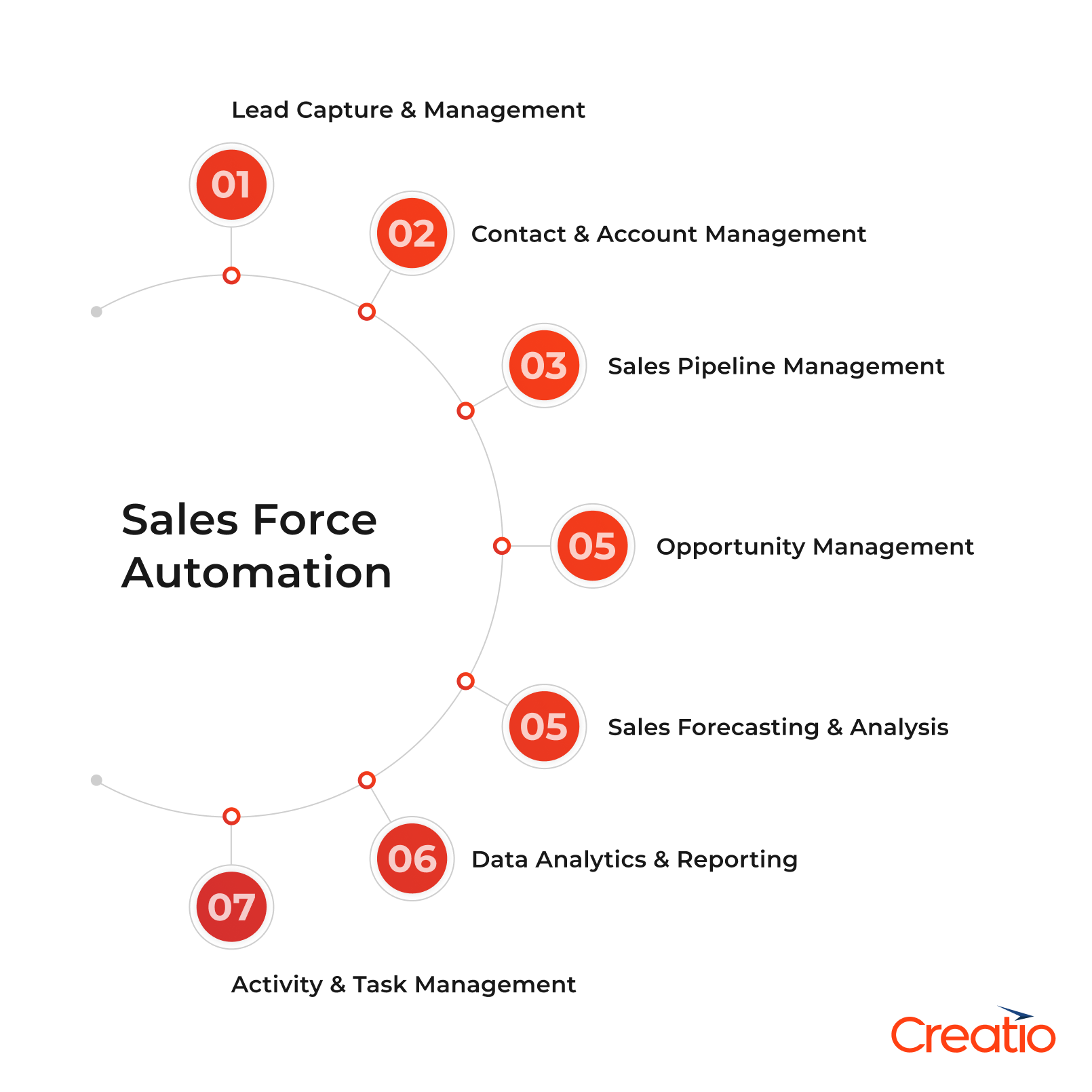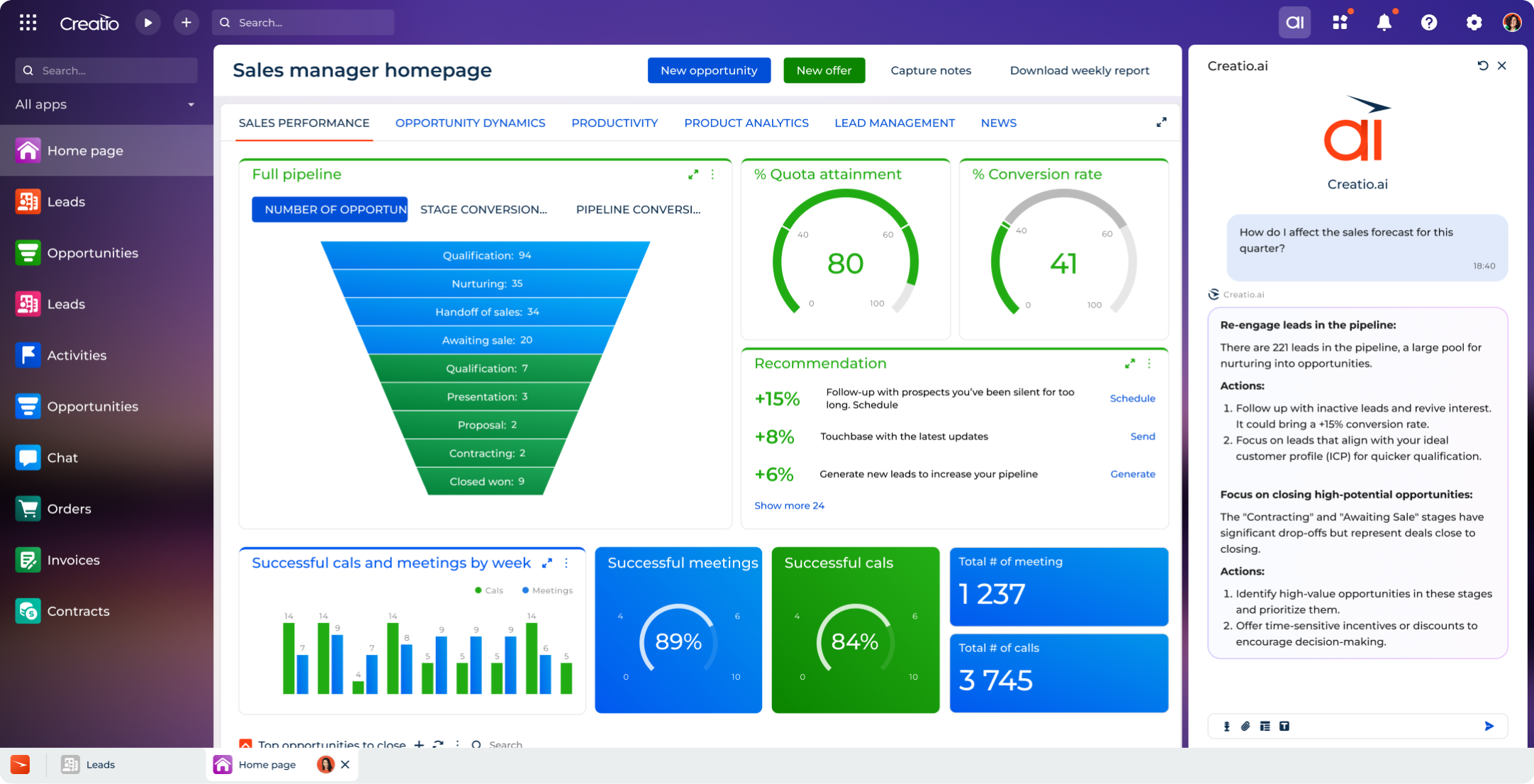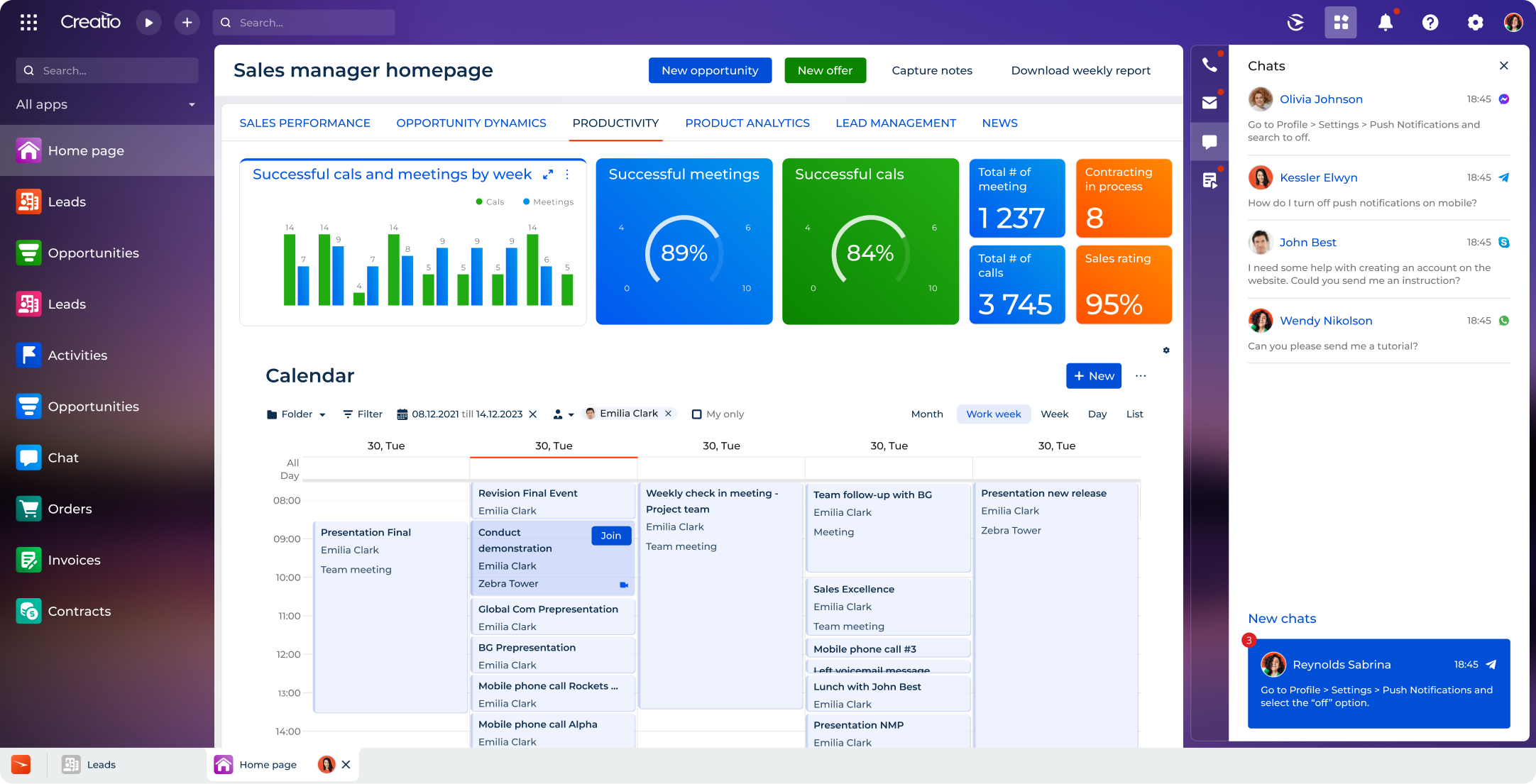-
No-Code
Platform
-
Studio
No-code agentic platform delivering the fastest time-to-value and the highest ROI
-
Studio
-
AI-Native CRM
CRM
-
AI-Native CRM
New era CRM to manage customer & operational workflows
CRM Products -
AI-Native CRM
- Industries
- Customers
- Partners
- About
Sales Force Automation: The Ultimate Guide to Accelerate Your Sales Process
Updated on
November 06, 2025
12 min read
Streamline Efficiency & Boost Sales Productivity with Creatio

By 2026, 30% of enterprises will automate more than half of their network activities, up from less than 10% in mid-2023, according to Gartner. This shift reflects a broader business trend, in which automation becomes essential for scaling operations and staying ahead of competitors.
For sales organizations, the pressure is even greater. Teams handle more channels, larger territories, and longer buying cycles, while manual updates and fragmented tools slow productivity and hinder accurate forecasting.
Sales force automation (SFA) offers a direct path to overcoming these challenges, helping organizations eliminate inefficiencies, improve visibility, and accelerate revenue growth without increasing headcount.
In this guide, you’ll learn the fundamentals of SFA: what it is, how it works, and how it can transform sales operations. We’ll also cover practical insights on choosing the right platform, real-world examples of sales force automation in action, and how solutions like Creatio Sales can help you accelerate performance and achieve long-term growth.
Key Takeaways:
- Sales force automation replaces manual, repetitive tasks with intelligent, rule-based workflows, empowering teams to improve efficiency, accuracy, and visibility across the entire sales cycle.
- While CRM software is primarily focused on customer relationship management for sales, marketing and service, sales force automation software enables sales teams to execute and automate various sales-related processes that help move deals forward.
- To ensure successful SFA rollout, organizations should start by defining goals, mapping workflows, identifying integration needs, and selecting a scalable, secure platform with no-code flexibility and powerful AI-native capabilities.
- The most effective sales force automation platforms combine AI and no-code capabilities, helping sales teams work faster, make data-driven decisions, and scale without adding complexity
- The best sales force automation platforms in 2025 include Creatio Sales, Zoho CRM, Microsoft Dynamics 365 Sales, HubSpot Sales Hub, and Salesforce, among others.
What is Sales Force Automation (SFA)?
Sales force automation (SFA) is the use of software and digital systems to automate repetitive or routine sales activities, helping organizations improve sales efficiency and drive revenue growth.
Through automation, sales teams can eliminate various manual tasks and time-consuming operations such as data entry, drafting follow-up emails, scheduling meetings, updating contact records, analyzing sales performance, forecasting revenue, and more. As a result, SFA enables sales reps to free up more time for high-value activities — building customer relationships, identifying opportunities, and closing deals.
From a company perspective, sales force automation helps streamline day-to-day operations, reduce administrative workload, and ensure consistent execution across every stage of the sales cycle. This leads to greater productivity, improved forecast accuracy, and a more scalable sales process overall.
How Does Sales Force Automation Work?
Traditional sales workflows often rely on manual processes that are slow, fragmented, and prone to delays. Sales representatives spend significant time updating records, sending follow-ups, and managing approvals — activities that reduce overall productivity and limit selling time.
Sales force automation streamlines these workflows by introducing automated, rule-based processes across the entire lead-to-sale journey. This ensures faster execution, consistent communication, and greater accuracy at every stage of the sales cycle:
- Inbound to first touch: Lead capture and enrichment from web forms or campaigns; automated scoring, routing by territory or rep, and first-touch outreach sequences.
- Qualification to discovery: Guided qualification steps with required fields and personas; automatic task creation for follow-ups and discovery calls.
- Proposal to quote: Standardized pricing and discount logic; automated quote generation and multi-level approval routing.
- Commit to close: Real-time forecast rollups, risk alerts for stalled or high-value deals, and next-step recommendations.
- Post-sale handoff: Automatic creation of onboarding or success tasks; data transfer to implementation teams for seamless customer transition.
By automating these steps, SFA helps organizations shorten sales cycles, maintain accuracy, and scale operations efficiently across teams and regions.
How is SFA different from CRM?
Although Sales Force Automation and Customer Relationship Management (CRM) are closely related, they serve different purposes within the sales ecosystem.
- CRM focuses on managing customer data and relationship history. It acts as a centralized database for all interactions, helping businesses understand who their customers are and how they engage with the company across different business functions (sales, marketing, customer service, and others).
- Sales force automation, on the other hand, focuses on executing and automating the sales process that move deals forward. It handles the operational side of selling by automating tasks, guiding reps through each stage of the pipeline, and ensuring meaningful, efficient interactions with clients.
Modern CRM systems like Creatio provide built-in SFA capabilities, allowing businesses to manage customer data and automate sales processes within a single platform. When combined, they create a unified environment that enhances visibility, improves forecasting accuracy, and enables business teams to work more efficiently across the entire customer lifecycle.
Main Benefits of Sales Force Automation
Implementing sales force automation brings measurable efficiency gains and greater control over the entire sales process. For medium and large organizations, it’s not just about saving time — it’s about improving accuracy, consistency, and scalability across distributed sales teams.
Increased Efficiency & Productivity
SFA automates a wide range of time-consuming administrative tasks such as data entry, scheduling, and follow-ups, allowing sales reps to focus on high-value activities like engaging clients and refining sales strategies. Modern systems also leverage analytics to forecast sales and suggest the next best actions, helping teams close deals faster and operate more efficiently.
Shorter Sales Cycles
By removing manual bottlenecks and automating repetitive tasks, sales automation accelerates deal progression across the entire sales pipeline. Automated approvals and real-time insights help sales teams spot opportunities earlier and act faster, improving conversion rates and overall pipeline velocity.
Reduced Human Error
Automated workflows minimize the risk of mistakes caused by manual data entry, missed updates, or inconsistent follow-ups. With cleaner data and standardized processes, sales teams can rely on accurate, up-to-date records for reporting and decision-making.
Enhanced Visibility & Forecasting
Centralized dashboards and automated reporting provide instant visibility into sales performance, pipeline health, and forecast accuracy. This allows leadership to make faster, data-driven decisions based on real-time metrics rather than static spreadsheets.
Greater Revenue Opportunities
By boosting efficiency and accelerating sales cycles, SFA directly contributes to higher win rates and sustained revenue growth. With predictive insights and proactive alerts, sales teams can identify new opportunities early and focus their efforts on the most promising sales leads.

AI-enhanced Opportunity Management by Creatio Sales
Improved Alignment Across Teams
SFA connects all business functions through shared data and unified workflows, ensuring teams operate with the same information and objectives. This alignment ensures smoother handoffs, consistent customer experiences across touchpoints, and stronger collaboration across the entire customer lifecycle.
Greater Scalability & Control
As organizations grow, sales automation allows them to manage more leads, regions, and product lines without adding administrative complexity. Automation of sales processes helps to maintain consistency across distributed teams, supporting global expansion while controlling costs.

Agentic Sales Dashboard by Creatio Sales
Core Features of Modern SFA Platforms
Modern sales force automation (SFA) software not just automates routine sales tasks, but also delivers visibility, intelligence, and scalability across the entire organization. Its fundamental capabilities typically include:

- Lead and Opportunity Management
Centralized tracking of leads, accounts, and opportunities with automated routing, scoring, and activity tracking to ensure no prospect is overlooked. - Pipeline and Forecast Management
Real-time visibility into deal stages, sales performance, and forecasts, enabling sales teams to track progress and predict outcomes with greater accuracy. - Workflow Automation
Rule-based automation for repetitive tasks, such as lead assignment, task creation, approval routing, and notifications, ensuring consistent execution. - Quote and Order Management
Automated quote generation, pricing, and discount logic with built-in approval flows that accelerate deal closures and maintain compliance. - Sales Analytics and Reporting
Interactive dashboards and analytics that provide actionable insights into sales performance, conversion rates, and pipeline health. - AI and Predictive Insights
Intelligent recommendations such as next-best actions, opportunity scoring, and risk detection to guide sales reps and improve decision-making. - Mobility and Remote Access
Mobile-ready interfaces that allow field and remote teams to manage opportunities, log activities, and update pipelines from any device on the go. - Collaboration Tools
Shared dashboards and integrated communication channels that help business teams quickly align around the same data and goals. - Data Management and Integration
Seamless integration with CRM, ERP, and specialized platforms to ensure unified, accurate, and up-to-date customer and sales data. - Scalability and Security
Enterprise-grade architecture that supports large user bases, complex territory structures, and multi-region operations. Modern SFA platforms also include advanced security and compliance controls such as role-based access, audit trails, and data encryption. Built-in tools for territory and partner management ensure consistent performance and governance as organizations expand globally.
This functionality help businesses standardize their sales processes, improve data accuracy, and scale workflows efficiently while maintaining full control over operations and customer engagement.
Best Sales Force Automation Software to Consider in 2025
Choosing the right sales force automation platform depends on your organization’s size, goals, and digital maturity. Below are some of the top-rated solutions for 2025, each offering strengths to help streamline sales processes and boost performance.
SFA software | Standout features | Rating |
| Creatio Sales | No-code flexibility, built-in AI tools and agents to automate routine sales activities, deliver context-driven recommendations, and enhance decision-making across the full sales cycle | G2: 4.7 Capterra: 4.7 |
| HubSpot Sales Hub | Easy-to-use interface, strong automation features for SMBs, and tight integration with HubSpot products | G2: 4.5 Capterra: 4.6 |
| Microsoft Dynamics 365 Sales | Deep integration with Microsoft 365 ecosystem, robust analytics, and AI-driven forecasting capabilities | G2: 3.8 Capterra: 4.6 |
| Zoho CRM | Great flexibility, AI insights and automation for SMBs; affordable pricing | G2: 4.3 Capterra: 4.3 |
| Salesforce | Scalable, enterprise-grade sales force automation software with advanced customization capabilities | G2: 4.3 Capterra: 4.4 |
| Oracle Sales | AI-powered automation and strong analytics for enterprise-scale deployments. | G2: 3.9 Capterra: 4.3 |
| SAP CRM | Comprehensive enterprise software with advanced process automation, analytics, and integration with ERP system | G2: 4.2 Capterra: - |
| Pipedrive | Intuitive and visual sales pipeline management tool, well-suited for SMBs and growing teams | G2: 4.3 Capterra: 4.5 |
| Freshsales | AI-enhanced sales automation software to streamline communications and gain predictive insights | G2: 4.5 Capterra: 4.5 |
When evaluating sales force automation tools, it’s essential to prioritize platforms that continuously innovate to keep pace with evolving sales trends and business needs. Organizations often prioritize platforms with AI, no-code capabilities, and scalable architecture, which enable them to adapt faster, optimize resources, and sustain a long-term competitive edge.
In 2025, Creatio was recognized as a Visionary in the Gartner® Magic Quadrant™ for Sales Force Automation Platforms. Year after year, Creatio Sales empowers organizations to achieve consistent sales growth through no-code flexibility and AI-native innovation, helping businesses accelerate revenue and scale efficiently.
SFA in Action: How BSN Sports Automated Sales Operations with Creatio
BSN Sports, one of the largest distributors of team sports equipment and uniforms in the United States, set out to modernize its sales operations and unify its technology ecosystem. To support continued growth and improve efficiency, the company adopted Creatio’s no-code platform to consolidate systems, automate critical sales processes, and provide real-time visibility across the organization.
Within months, BSN Sports achieved a 100% adoption rate and delivered a 60% increase in sales growth. The transformation has reshaped the company’s sales culture, enabling teams to sell proactively, make faster decisions, and rely on data-driven insights rather than intuition.
Key automation outcomes include:
- Automated pipeline progression with real-time visibility into pipeline health, win rates, and rep performance.
- Data-driven forecasting and analytics that provide accurate sales projections and guided smarter resource allocation.
Intelligent lead and order management that automatically flags changes or issues, allowing sales reps to respond quickly to opportunities during the fulfillment process.
We've been able to move our sales book size in the last five years, about 50 to 60% larger per sales pro, and we expect that to continue as we drive more digital enhancements for Creatio in the future.
See how BSN Sports enhanced its business growth with no-code sales automation. Read the full story.
Choosing the Right Sales Force Automation Approach
Selecting the right sales force automation platform requires a clear understanding of your business needs and long-term objectives. Here are the five key steps to help you ensure the software delivers measurable impact to your business:
Step 1: Define your goals and success metrics
Start by identifying the challenges you want to solve, such as slow lead response, low forecast accuracy for prospective customers, or limited visibility in prioritizing leads. Set clear KPIs to measure improvement once the platform is deployed.
Step 2: Map and assess your sales process
Review your entire lead-to-sale journey to uncover inefficiencies, manual tasks, and data gaps. Understanding how your teams work today will clarify what should be automated first.
Step 3: Identify key requirements and integrations
Outline the must-have capabilities that will guide your decision-making process. lead routing, quote and approval workflows, forecasting, and reporting. Ensure the platform can integrate seamlessly with existing CRM, ERP, or marketing systems.
Step 4: Evaluate usability and scalability
Choose a platform that sales teams can adopt easily and that can scale with your organization. For example, modern SFA solutions with no-code capabilities allow users to quickly customize and continuously improve sales processes without extensive IT effort.
Step 5: Verify security, support, and total cost
Enterprise adoption requires strong data protection and dependable vendor support. At this phase, we recommend evaluating security controls, implementation process, and total cost of ownership for each SFA vendor. Whenever possible, run a pilot to test usability within real sales workflows, and ensure the vendor offers thorough onboarding and training to drive quick adoption.
Accelerate Sales Workflows with Creatio
Creatio offers a new era of agentic platforms, designed to accelerate end-to-end workflows across sales, marketing, service, and industry-specific verticals with no-code and AI at its core. Its composable architecture enables organizations to automate processes of any type or complexity and easily adapt the platform to different industries, workflows, and business needs.
The platform combines powerful sales automation capabilities for lead management, opportunity tracking, forecasting, and analytics, making it an ideal solution for businesses looking to streamline operations and boost efficiency.

Sales Forecasting and Performance Management by Creatio
Alongside its no-code agentic platform, Creatio offers specialized CRM products for sales, marketing, and service, all enhanced by AI-native tools and agents. Built on Creatio’s no-code agentic platform, each product is fully customizable, empowering organizations to design, modify, and scale applications, workflows, and AI agents without technical constraints. Specifically, Creatio Sales helps teams accelerate deal cycles, manage leads and opportunities, automate forecasting, and apply guided selling to increase productivity.

Sales Productivity Management & Team Collaboration by Creatio
With Creatio Sales, teams can automate complex operations, customize workflows with no-code tools, and deploy AI sales agents tailored to their unique processes. Reps can create their own digital assistants or use ready-to-go AI agents such as:
- Account Research Agent – automatically gathers and updates account data to keep records accurate and complete.
- Quote Generation Agent – prepares quotes and proposals based on pricing rules and discount policies.
- Meeting Preparation Agent – collects relevant customer insights, deal history, and talking points before meetings.
- Forecasting Agent – analyzes pipeline data to deliver accurate forecasts and identify potential gaps.
- Territory Management Agent – optimizes territory assignments and ensures balanced workload distribution.
- Field Sales Agent – supports on-the-go reps with mobile access to accounts, opportunities, and schedules.
- …and more.
By combining sales force automation capabilities with no-code and AI, Creatio empowers sales teams to work smarter, act faster, and make data-driven decisions in real time.
According to Nucleus Research, companies using Creatio achieve implementations 70% faster, experience a 37% lower total cost of ownership (TCO), and see 67% quicker lead response times compared to legacy systems.
Whether your goal is to accelerate deal velocity, enhance forecasting accuracy, or deliver hyper-personalized customer experiences, Creatio Sales provides the flexibility and intelligence to help your teams sell more effectively and efficiently.
Summary
With the right sales force automation software, your organization can eliminate repetitive manual work, streamline sales processes, and gain complete visibility across the pipeline. SFA software not just automates tasks, but will also help your company maximize performance, accelerate revenue growth, and empower your teams to focus on high-value work.
At Creatio, we understand the challenges growing businesses face in managing complex sales cycles, distributed teams, and evolving customer expectations. Our no-code, AI-powered agentic platform helps organizations automate sales workflows, enhance forecasting accuracy, and build scalable, data-driven operations that drive consistent results.
Ready to see how Creatio can help you accelerate your sales performance?
Start your free trial or request a personalized demo today!
























































